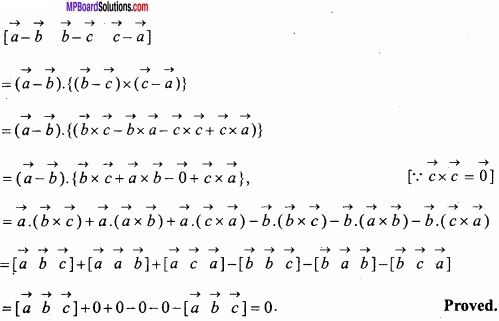MP Board Class 12th Maths Important Questions Chapter 10 Vector Algebra
Vector Algebra Important Questions
Vector Algebra Objective Type Questions
Question 1.
Choose the correct answer:
Question 1.
Unit vector parallel to the resultant vector of vectors 2\(\hat { i } \) + 4\(\hat { j } \) – 5\(\hat { k } \) and \(\hat { i } \) + 2\(\hat { j } \) + 3\(\hat { k } \) is:
(a) – \(\hat { i } \) – \(\hat { j } \) + 8\(\hat { k } \)
(b) \(\frac { 3\hat { i } +6\hat { j } -2\hat { k } \quad }{ 7 } \)
(c) \(\frac { -\hat { i } -+8\hat { k } \quad }{ \sqrt { 69 } } \)
(d) \(\frac { -\hat { i } +2\hat { j } -8\hat { k } \quad }{ \sqrt { 69 } } \)
Question 2.
If \(\vec { O } \)A = a, \(\vec { O } \)B = b and C is a point on AB such that \(\vec { A } \)C = 3AB, then \(\vec { O } \)C is equal to:
(a) 3\(\vec { a } \) – 2\(\vec { b } \)
(b) 3\(\vec { b } \) – 2\(\vec { a } \)
(c) 3\(\vec { a } \) – \(\vec { b } \)
(d) 3\(\vec { b } \) – \(\vec { a } \)
![]()
Question 3.
If \(\vec { a } \) and \(\vec { b } \) are two vectors such that |\(\vec { a } \)| = 2, |\(\vec { b } \)| = 1 and \(\vec { a } \).\(\vec { b } \) = \(\sqrt { 3 } \), then the angle between them is:
(a) \(\frac { \pi }{ 2 } \)
(b) \(\frac { \pi }{ 4 } \)
(c) \(\frac { \pi }{ 6 } \)
(d) \(\frac { \pi }{ 7 } \)
Question 4.
Area of parallelogram whose adjacent sides are \(\hat { i } \) – 2\(\hat { j } \) + 3\(\hat { k } \) and 2\(\hat { i } \) + \(\hat { j } \) – 4\(\hat { k } \) is:
(a) 3\(\sqrt{6}\)
(b) 4\(\sqrt{6}\)
(c) 5\(\sqrt{6}\)
(d) 6\(\sqrt{6}\)
Question 5.
If \(\vec { a } \) = \(\vec { b } \) + \(\vec { c } \), then \(\vec { a } \).( \(\vec { b } \) × \(\vec { c } \) ) is equal to:
(a) 2\(\vec { a } \). ( \(\vec { b } \) + \(\vec { c } \) )
(b) 0
(c) \(\vec { b } \) = ( \(\vec { a } \) + \(\vec { c } \) )
(d) None of these
Question 2.
Fill in the blanks:
- Sum or difference of two vectors is always a ………………………….
- Addition of vectors obeys ………………………….
- ( \(\vec { a } \) + \(\vec { b } \) ) + \(\vec { c } \) = \(\vec { a } \) + …………………………..
- Addition of two vectors can be obtained from ……………………………..
- Position vector of point (1,2, 3) w.r.t. the origin will be ……………………………..
- If \(\vec { a } \) and \(\vec { b } \) are parllel then \(\vec { a } \) × \(\vec { b } \) = …………………………..
- If \(\vec { a } \) and \(\vec { b } \) are parallel then \(\vec { a } \) × \(\vec { a } \) = ………………………..
- The unit vector in the direction of vector \(\vec { a } \) will be ……………………………
- The projection of \(\vec { b } \) along the direction of \(\vec { a } \) will be ……………………………..
- If the vectors 2\(\hat { i } \) – \(\hat { j } \) + \(\hat { k } \) 3\(\hat { i } \) + p\(\hat { j } \) + 5\(\hat { k } \) are coplanar then value of p will be …………………………….
- A force 2\(\hat { i } \) + \(\hat { j } \) + \(\hat { k } \), acts at a point A whose position vector 2\(\hat { i } \) – \(\hat { j } \) The moment of the force with respect to the origin will be ………………………………..
- The area of the parallelogram will be …………………………. whose diagonals are 3\(\hat { i } \) + \(\hat { j } \) – 2\(\hat { k } \) and \(\hat { i } \) – 3\(\hat { j } \) + 4\(\hat { k } \).
Answer:
- New vector
- Commutative and associative law
- ( \(\vec { b } \) + \(\vec { c } \) )
- Traingle law of vector addition
- \(\hat { i } \) + 2\(\hat { j } \) + 3\(\hat { k } \)
- collinear
- \(\vec { O } \)
- \(\frac { \vec { a } }{ |\vec { a } | } \)
- \(\frac { \vec { a } .\vec { b } }{ |\vec { a } | } \)
- -4
- \(\hat { i } \) + 2\(\hat { j } \) + 4\(\hat { k } \)
- 5\(\sqrt { 3 } \) sq. unit.
![]()
Question 3.
Write True/False:
- The sum of the vectors determined by the sides of a triangle taken in order is zero.
- If \(\vec { a } \) and \(\vec { b } \) are two non collinear vectors, then |\(\vec { a } \) + \(\vec { b } \)| ≥ |\(\vec { a } \) + \(\vec { b } \)|
- A vector whose initial and terminal points are coincident is called unit vector.
- If the position vector of the points P and Q are \(\hat { i } \) + 3\(\hat { j } \) – 7\(\hat { k } \) and 5\(\hat { i } \) – 2\(\hat { j } \) + 4\(\hat { k } \) respectively, then the value of |\(\vec { P } \)Q| is 9\(\sqrt { 2 } \).
- If |\(\vec { a } \) + \(\vec { a } \)|=|\(\vec { a } \) – \(\vec { b } \)|, then \(\vec { a } \) × \(\vec { b } \) = \(\vec { 0 } \).
- The value of \(\vec { a } \).( \(\vec { a } \) × \(\vec { b } \) ) is zero.
- If the vectors \(\hat { i } \) – λ\(\hat { j } \) + \(\hat { k } \) and \(\hat { i } \) – \(\hat { j } \) + 5\(\hat { k } \) are mutually perpendicular, then the value of λ is 6.
Answer:
- True
- False
- False
- True
- False
- True
- False.
![]()
Question 4.
Write the answer is one word/sentence:
- If \(\vec { a } \), \(\vec { b } \), \(\vec { c } \) are the position vectors of the vectors of the ∆ABC, then write the formula for area of ∆ABC.
- If \(\vec { a } \) = \(\hat { i } \) – 2\(\hat { j } \) + 3\(\hat { k } \),\(\vec { b } \) = 2\(\hat { i } \) + \(\hat { j } \) – \(\hat { k } \) and \(\vec { c } \) = \(\hat { j } \) + \(\hat { k } \), then find the value of [ \(\vec { a } \) \(\vec { b } \) \(\vec { c } \) ]
- Find the angle between two vector 3\(\hat { i } \) – 2\(\hat { j } \) + 4\(\hat { k } \) and \(\hat { i } \) – \(\hat { j } \) + 5\(\hat { k } \).
- Find the value of \(\hat { i } \) × ( \(\hat { j } \) + 3\(\hat { k } \) ) + \(\hat { j } \) × ( \(\hat { k } \) + \(\hat { i } \) ) + \(\hat { k } \) × ( \(\hat { i } \) + \(\hat { j } \) )
- Find the projection of \(\vec { a } \) in the direction of \(\vec { b } \).
- If \(\vec { a } \) and \(\vec { b } \) are mutually perpendicular vector then find, the value ( \(\vec { a } \) + \(\vec { b } \) ) 2
Answer:
- \(\frac{1}{2}\) |\(\vec { a } \) × \(\vec { b } \) + \(\vec { b } \) × \(\vec { c } \) + \(\vec { c } \) × \(\vec { a } \)|
- 12
- cos-1 \(\frac { 25 }{ \sqrt { 783 } } \)
- 0
- \(\frac { \vec { a } .\vec { b } }{ |\vec { b } | } \)
- |\(\vec { a } \)|2 + |\(\vec { b } \)|2
Question 4.
Match the Column:
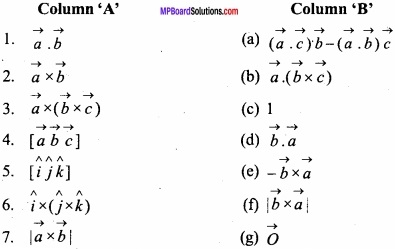
Answer:
- (d)
- (e)
- (a)
- (b)
- (c)
- (g)
- (f).
Vector Algebra Very Short Answer Type Questions
Question 1.
Given vectors \(\vec { a } \) = \(\hat { i } \) – 2\(\hat { j } \) + \(\hat { k } \), \(\vec { b } \) = – 2\(\hat { i } \) + 4\(\hat { j } \) + 5\(\hat { k } \) and \(\vec { c } \) = \(\hat { i } \) – 6\(\hat { j } \) – 7\(\hat { k } \). Then find the value of |\(\vec { a } \) + \(\vec { b } \) + \(\vec { c } \)|? (NCERT, CBSE 2012)
Solution:
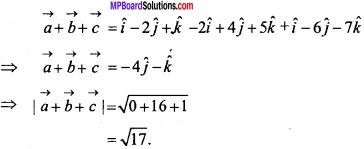
Question 2.
Find the unit vector in the direction of sum of the vectors \(\vec { a } \) = 2\(\hat { i } \) – \(\hat { j } \) + 2\(\hat { k } \) and \(\vec { b } \) = – \(\hat { i } \) + \(\hat { j } \) + 3\(\hat { k } \)?
Solution:
![]()
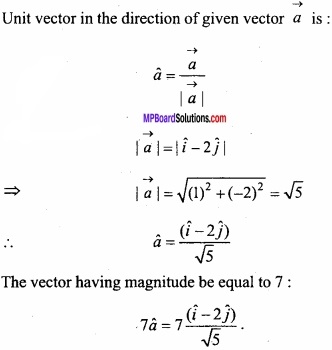
Question 3.
Find the vector in the direction of vector \(\vec { a } \) = \(\hat { i } \) – 2\(\hat { j } \) which has magnitude 7 units? (NCERT)
Solution:
\(\vec { a } \) = \(\hat { i } \) – 2\(\hat { j } \)
Unit vector in the direction of given vector a is:
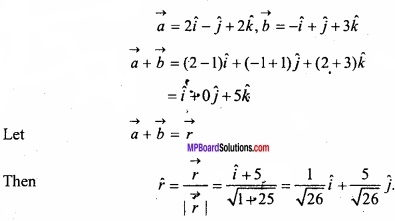
The vector having magnitude be equal to 7:

Question 4.
Prove that the vectors 2\(\hat { i } \) – 3\(\hat { j } \) + 4\(\hat { k } \) and -4\(\hat { i } \) + 6\(\hat { j } \) – 8\(\hat { k } \) are collinear? (NCERT)
Solution:
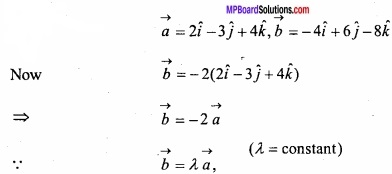
Hence vector \(\vec { a } \), \(\vec { b } \) are collinear. Proved.
Question 5.
Find direction cosine of the vector \(\hat { i } \) + 2\(\hat { j } \) + 3\(\hat { k } \)? (NCERT)
Solution:
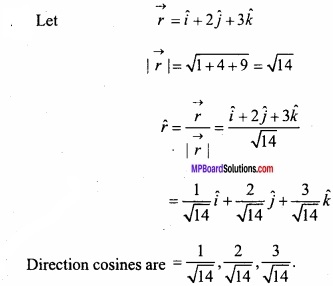
Question 6.
If \(\vec { a } \) = 2 \(\hat { i } \) – 3 \(\hat { j } \) + \(\hat { k } \) and \(\vec { a } \) = \(\hat { i } \) + \(\hat { j } \) – 2\(\hat { k } \), then find \(\vec { a } \) – \(\vec { b } \)?
Solution:
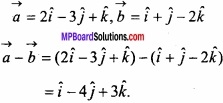
Question 7.
If \(\vec { a } \) = \(\hat { i } \) + \(\hat { j } \) + 2\(\hat { k } \) and \(\vec { b } \) = 3\(\hat { i } \) + 2\(\hat { j } \) – \(\hat { k } \), then find |2\(\vec { a } \) – \(\vec { b } \)|?
Solution:
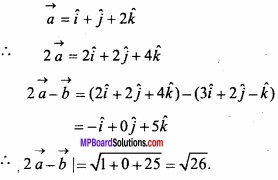
Question 8.
If the vector \(\vec { a } \) = 2\(\hat { i } \) + \(\hat { j } \) + \(\hat { k } \) and \(\vec { b } \) = \(\hat { i } \) – 4\(\hat { j } \) + λ\(\hat { k } \) are perpendicular then find the value of λ?
Solution:
The given vectors are perpendicular
Hence \(\vec { a } \) . \(\vec { b } \) = 0
(2\(\hat { i } \) + \(\hat { j } \) + \(\hat { k } \) ). ( \(\hat { i } \) – 4\(\hat { j } \) + λ\(\hat { k } \) ) = 0
⇒ 2 – 4 + λ = 0
⇒ λ = 2.
![]()
Question 9.
(A) Prove that the vectors 2\(\hat { i } \) – \(\hat { j } \) + \(\hat { k } \) and –\(\hat { i } \) + 3\(\hat { j } \) + 5\(\hat { k } \) are perpendicular to each other?
Solution:
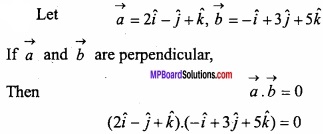
L.H.S = – 2 – 3 + 5
= 0 = R.H.S. Proved
(B) Prove that vector 3\(\hat { i } \) – 2\(\hat { j } \) + \(\hat { k } \) and 2\(\hat { i } \) + \(\hat { j } \) – 4\(\hat { k } \) are perpendicular?
Solution:
Solve as Q.No. 9(A)
Question 10.
If \(\vec { a } \) = 4\(\hat { i } \) – \(\hat { j } \) + \(\hat { k } \) and \(\vec { b } \) p\(\hat { i } \) + 2\(\hat { j } \) + 3\(\hat { k } \) are perpendicular. Find the value of p?
Solution:
\(\vec { a } \) = 4\(\hat { i } \) – \(\hat { j } \) + \(\hat { k } \) and \(\vec { b } \) p\(\hat { i } \) + 2\(\hat { j } \) + 3\(\hat { k } \)
\(\vec { a } \) and \(\vec { b } \) are perpendicular
\(\vec { a } \).\(\vec { b } \) = 0
∴ 4p – 2 + 3 = 0
⇒ 4p = -1
⇑ p = – \(\frac{1}{4}\)
Question 11.
(A) Find the angle between the vectors (2\(\hat { i } \) + 3\(\hat { j } \) – 4\(\hat { k } \) ) and (3\(\hat { i } \) + 2\(\hat { j } \) + 3\(\hat { k } \) )?
Solution:
Let \(\vec { a } \) = 2\(\hat { i } \) + 3\(\hat { j } \) – 4\(\hat { k } \), \(\vec { b } \) = 3\(\hat { i } \) + 2\(\hat { j } \) + 3\(\hat { k } \)
Let θ be the angle between them
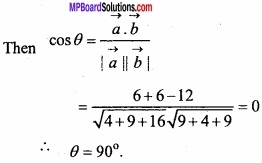
(B) Find the angle between vectors \(\vec { a } \) = 2\(\hat { i } \) – 2\(\hat { j } \) – \(\hat { k } \) and \(\vec { b } \) = 6\(\hat { i } \) – 3\(\hat { j } \) + 2\(\hat { k } \)?
Solution:
Solve as Q.No. 11(A)
![]()
(C) If \(\vec { a } \) = 2\(\hat { i } \) – \(\hat { j } \) + \(\hat { k } \) and \(\vec { b } \) = 3\(\hat { i } \) – 4\(\hat { j } \) – 4\(\hat { k } \), then find their dot product and angle between them?
Solution:

If θ be the angle between them
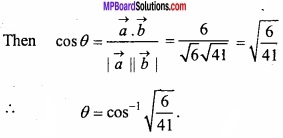
Question 12.
If |\(\bar { |a| } \) = 10, \(\bar { |b| } \) = 2 and \(\bar { a } \). \(\bar { b } \) = 2 and \(\bar { a } \). \(\bar { b } \) = 12, then find the value of |\(\bar { a } \) × \(\bar { b } \)?
Solution:

Question 13.
If \(\vec { a } \) = \(\hat { i } \) + \(\hat { j } \) + \(\hat { k } \) and \(\vec { b } \) = \(\hat { i } \) – \(\hat { j } \) – \(\hat { k } \), then find \(\vec { a } \) × \(\vec { b } \)?
Solution:
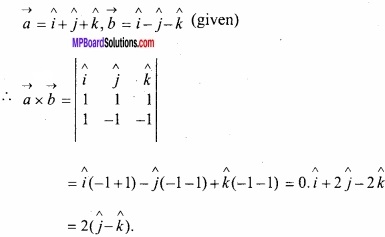
Question 14.
A force \(\vec { F } \) = 4\(\hat { i } \) – 3\(\hat { j } \) + 2\(\hat { k } \) is acting along the direction \(\vec { d } \) = – \(\hat { i } \) – 3\(\hat { j } \) + 5\(\hat { k } \)? Find the work done by the force?
Solution:
\(\vec { d } \) = – \(\hat { i } \) – 3\(\hat { j } \) + 5\(\hat { k } \), \(\vec { F } \) = 4\(\hat { i } \) – 3\(\hat { j } \) + 2\(\hat { k } \) (given)
∴ Work done by force
W = \(\vec { F } \). \(\vec { d } \)
= (4\(\hat { i } \) – 3\(\hat { j } \) + 2\(\hat { k } \) ). (-\(\hat { i } \) – 3\(\hat { j } \) + 5\(\hat { k } \) )
= -4 + 9 + 10 = 15 unit.
![]()
Question 15.
If |\(\vec { a } \) + \(\vec { b } \)| = |\(\vec { a } \) – \(\vec { b } \)|, then prove that \(\vec { a } \) and \(\vec { b } \) are perpendicular?
Solution:
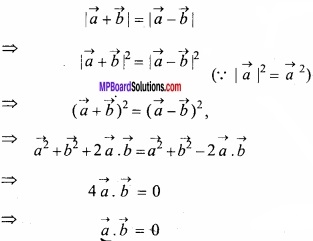
Since dot product is zero. So vectors \(\vec { a } \) and \(\vec { b } \) are perpendiculars. Proved.
Question 16.
If \(\vec { a } \) and \(\vec { b } \) are two vectors such that |\(\vec { a } \)| = 2, |\(\vec { b } \)| = 3 and \(\vec { a } \). \(\vec { a } \) = 3, then find angle between \(\vec { a } \) and \(\vec { b } \)?
Solution:
Solve as Q.No. 17
Question 17.
If |\(\vec { a } \)| = 4, |\(\vec { b } \)| = 4 and \(\vec { a } \). \(\vec { b } \) = 6, then find the angle between \(\vec { a } \) and \(\vec { b } \)?
Solution:
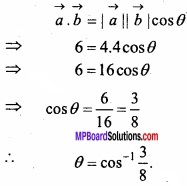
Question 18.
If \(\vec { a } \) and \(\vec { b } \) are two two vectors such that |\(\vec { a } \)| = 2, |\(\vec { b } \)| = 7 and \(\vec { a } \) ×
\(\vec { b } \) = 3\(\hat { i } \) + 2\(\hat { j } \) + 6\(\hat { k } \), then find the angle between \(\vec { a } \) and \(\vec { b } \)?
Solution:
Let θ be the angle between \(\vec { a } \) and \(\vec { b } \)
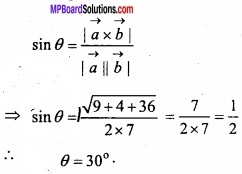
Question 19.
Find cosine angle between vectors 2\(\hat { i } \) – 3\(\hat { j } \) + \(\hat { k } \) and \(\hat { i } \) + \(\hat { j } \) – 2\(\hat { k } \)?
Solution:
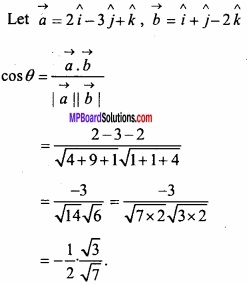
Question 20.
Find the area of the parallelogram whose two adjacent sides are represented by the vectors \(\vec { a } \) = 2\(\hat { i } \) – 3\(\hat { j } \) + \(\hat { k } \), \(\vec { b } \) = \(\hat { i } \) – \(\hat { j } \) + 2\(\hat { k } \) and \(\vec { c } \) = 2\(\hat { i } \) + \(\hat { j } \) – \(\hat { k } \)?
Solution:
![]()
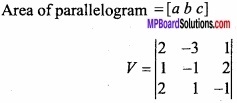
= 2(1 – 2) + 3(-1-4) + 1(1 + 2)
= -2 – 15 + 3
= -14 cubic unit
Question 21.
Prove that:
\(\hat { i } \).( \(\hat { j } \) × \(\hat { k } \) + ( \(\hat { i } \) × \(\hat { k } \)). \(\hat { j } \) = 0?
Solution:
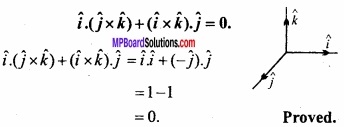
Question 22.
If vectors \(\vec { a } \) and \(\vec { b } \) are perpendicular then prove that |\(\vec { a } \) + \(\vec { b } \)|2 = |\(\vec { a } \)|2 + |\(\vec { b } \)|2?
Solution:
We know that
|\(\vec { a } \) + \(\vec { b } \)|2 = |\(\vec { a } \)|2 + |\(\vec { b } \)|2
Vector \(\vec { a } \) and \(\vec { b } \) are perpendicular, then
\(\vec { a } \). \(\vec { b } \) = 0
⇒ |\(\vec { a } \) + \(\vec { a } \)|2 + |\(\vec { a } \)|2 + |\(\vec { b } \)|2. Proved.
Question 23.
Prove that:
\(\vec { a } \) × ( \(\vec { b } \) + \(\vec { c } \) ) + \(\vec { b } \) × ( \(\vec { c } \) + \(\vec { a } \) ) + \(\vec { c } \) × ( \(\vec { a } \) + \(\vec { b } \) ) = \(\vec { 0 } \)?
Solution:
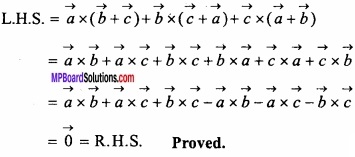
Question 24.
Find the work done by the force \(\vec { F } \) = 2\(\hat { i } \) – \(\hat { j } \) + \(\hat { k } \) in the direction \(\vec { d } \) = 3\(\hat { i } \) + 2\(\hat { j } \) + 5\(\hat { k } \)?
Solution:
W = \(\vec { F } \). \(\vec { d } \)
= (2\(\hat { i } \) – \(\hat { j } \) + \(\hat { k } \) ). (3\(\hat { i } \) + 2\(\hat { j } \) + 3\(\hat { k } \) )
= 6 – 2 + 3 = 7 unit.
![]()
Question 25.
If modulus of two vectors \(\vec { a } \) and \(\vec { a } \) are equal and angle between them is 60° and their dot product is \(\frac{9}{2}\) find their modulus? (CBSE 2018)
Solution:
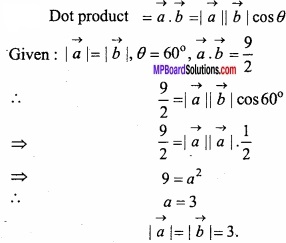
Question 26.
Find the area of the parallelogram whose adjacent sides are given by vectors \(\vec { a } \) = 2\(\hat { i } \) – \(\hat { j } \) + \(\hat { k } \) and \(\vec { b } \) = 3\(\hat { i } \) + 4\(\hat { j } \) – \(\hat { k } \)?
Solution:
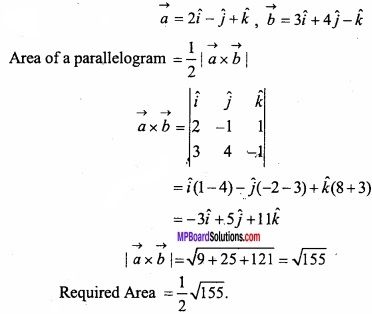
Question 27.
If \(\vec { a } \) = 4\(\hat { i } \) + \(\hat { j } \) + \(\hat { k } \), \(\vec { b } \) = \(\hat { i } \) – 2\(\hat { k } \) then find the value of |2\(\vec { b } \) × \(\vec { a } \)|?
Solution:

Question 28.
If \(\vec { a } \) = 4\(\hat { i } \) + 3\(\hat { j } \) + 3\(\hat { k } \) and \(\vec { b } \) = 3\(\hat { i } \) + 2\(\hat { k } \) then, find the value of |\(\vec { b } \) × 2\(\vec { a } \)|?
Solution:

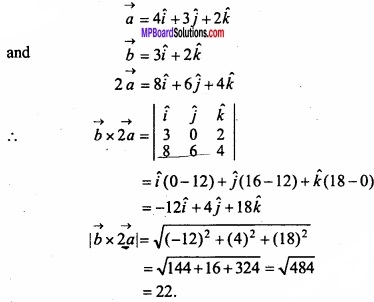
Question 29.
If \(\vec { a } \) = 2\(\hat { i } \) + \(\hat { j } \) + 2\(\hat { k } \) and \(\vec { b } \) = 5\(\hat { i } \) – 3\(\hat { j } \) + \(\hat { k } \), then find the magnitude of vector \(\vec { b } \) in the direction of \(\vec { a } \)?
Solution:
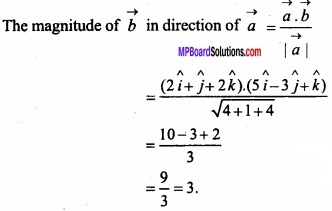
Question 30.
If \(\vec { a } \) = \(\hat { i } \) + 3\(\hat { j } \) – 2\(\hat { k } \), \(\vec { b } \) = – \(\hat { j } \) + 3\(\hat { k } \) then find the value |\(\vec { a } \) × \(\vec { b } \)|?
Solution:
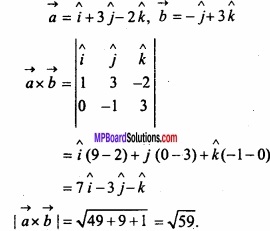
Vector Algebra Short Answer Type Questions
Question 1.
Prove that: A(-2\(\hat { i } \) + 3\(\hat { j } \) + 5\(\hat { k } \) ), B( \(\hat { i } \) + 2\(\hat { j } \) + 3\(\hat { k } \) ) and C(7\(\hat { i } \) + 0\(\hat { j } \) – \(\hat { k } \) ) are coplanar? (NCERT)
Solution:
Let O be the origin then position vector of A, B and C is
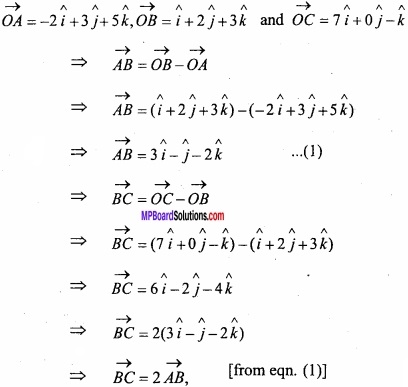
Hence vector \(\vec { A } \)B and \(\vec { B } \)C are parallel but \(\vec { A } \)B and \(\vec { B } \)C has common point B. Hence points A, B and C are coplanar.
![]()
Question 2.
If position vectors of points A, B, C and D are 2\(\hat { i } \) + 4\(\hat { k } \), 5\(\hat { i } \) + 3\(\sqrt { 3 } \) \(\hat { j } \) + 4\(\hat { k } \), -2\(\sqrt { 3 } \) \(\hat { j } \) + \(\hat { k } \) then prove that:
CD||AB and CD = \(\frac{2}{3}\) \(\vec { A } \)B?
Solution:
Let O be the origin
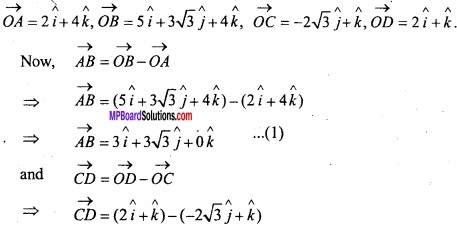
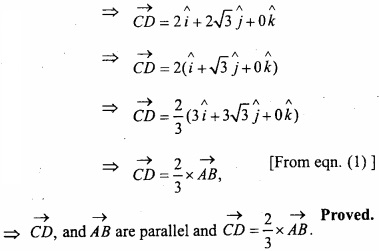
Question 3.
If G is centroid of ∆ABC, then prove that:
\(\vec { G } \)A + \(\vec { G } \)B + \(\vec { G } \)C = \(\vec { 0 } \)?
Solution:
Let vectors of vertices A,B and C of ∆ABC are \(\vec { a } \), \(\vec { b } \) and \(\vec { c } \) respectively.
∴ Position vector of centroid G = \(\frac { \vec { a } +\vec { b } +\vec { c } }{ 3 } \)
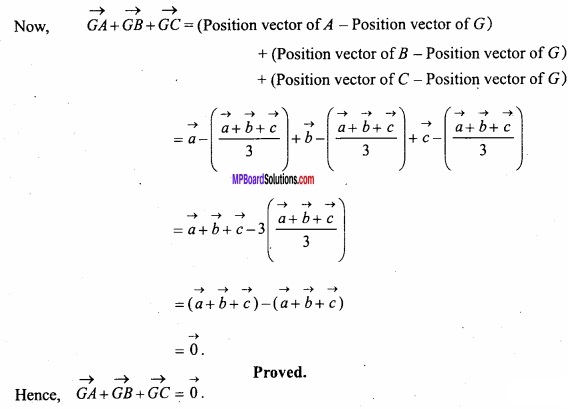
Question 4.
Using vectors prove that the medians of traiangle are concurrent?
Solution:
Let medium of ∆ABC are AD, BE and CF.
Let \(\vec { a } \), \(\vec { b } \) and \(\vec { c } \) be the positive vector of points A, B and C respectively.
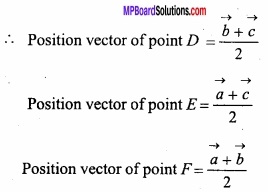
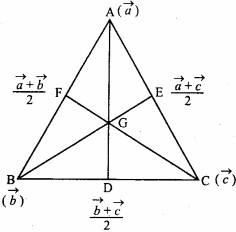
Now position vector of a point dividing the median AD in the ratio 2 : 1 is

Position vector of a point which divides median BE in the ratio of 2 : 1 is

Position vector of a point which divides median BE in the ratio of 2 : 1 is

Hence, medians of triangle meets at point G it means concurrent whose position vector is \(\frac { \vec { a } +\vec { b } +\vec { c } }{ 3 } \). Point G is centroid of traingle.
Question 5.
A vector \(\vec { O } \)P, makes angle 45° with OX and 60° with OY. Find the angle made by \(\vec { O } \)P with OZ?
Solution:
Let angle made by vector \(\vec { O } \)P with axes OX, OY and OZ are α, β, γ respectively. then
α = 45°,
β = 60°
∴ l = cos α = cos 45° = \(\frac { 1 }{ \sqrt { 2 } } \)
m = cos β = cos 60° = \(\frac{1}{2}\)
and n = cos γ
We know that
l2 + m2 + n2 = 1
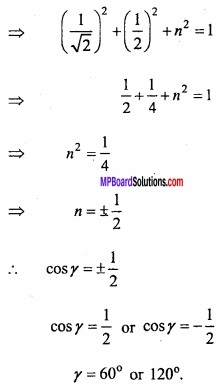
![]()
Question 6.
Find the vector \(\vec { a } \) which makes an angle with X – axis, F – axis and Z – axis respectively are \(\frac { \pi }{ 4 } \), \(\frac { \pi }{ 2 } \) and angle θ and its magnitude is 5\(\sqrt { 2 } \)?
Solution:
Given:
α = \(\frac { \pi }{ 4 } \),
β = \(\frac { \pi }{ 2 } \), γ = θ
∴l = cos \(\frac { \pi }{ 4 } \) = \(\frac { 1 }{ \sqrt { 2 } } \), m = cos \(\frac { \pi }{ 2 } \) = 0, n = cos θ.
We know that
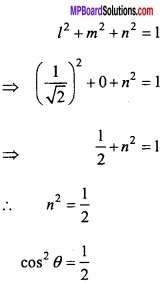

Direction cosine of vector \(\frac { 1 }{ \sqrt { 2 } } \), 0 , \(\frac { 1 }{ \sqrt { 2 } } \)
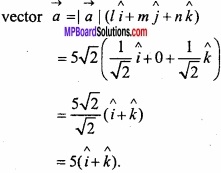
Question 7.
Prove that:
( \(\vec { a } \) × \(\vec { b } \) )2 = a2b2 – ( \(\vec { a } \).\(\vec { b } \) )2?
Solution:
L.H.S = ( ( \(\vec { a } \) × \(\vec { b } \) )2 = ( \(\vec { a } \) × \(\vec { b } \) ).( \(\vec { a } \) × \(\vec { b } \) )
= (ab sin θ\(\hat { n } \) ). (ab sin θ \(\hat { n } \) ) = a2 b2 sin2θ,
= a2 b2 (1 – cos2θ)
= a2 b2 – a2 b2cos2θ
= a2 b2 – (ab cos θ)2
= a2 b2 – ( \(\vec { a } \). \(\vec { b } \) )2 = R.H.S Proved.
Question 8.
If \(\vec { a } \) = 2\(\hat { i } \) – 3\(\hat { j } \) + \(\hat { k } \), \(\vec { b } \) = \(\hat { i } \) – \(\hat { j } \) + 2\(\hat { k } \) and \(\vec { c } \) = 2\(\hat { i } \) + \(\hat { j } \) – \(\hat { k } \) then find the value of \(\vec { a } \) × ( \(\vec { b } \) × \(\vec { c } \) )?
Solution:
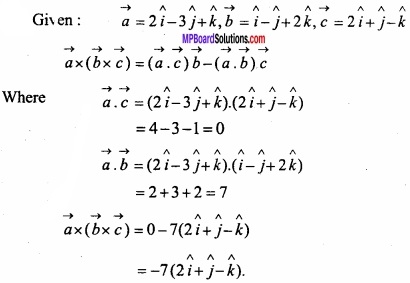
![]()
Question 9.
Find the volume of parallel cuboid whose vectors of three faces are denoted by: \(\hat { i } \) + \(\hat { j } \) + \(\hat { k } \), \(\hat { i } \) – \(\hat { j } \) + \(\hat { k } \), \(\hat { i } \) + \(\hat { j } \) – \(\hat { k } \)?
Solution:
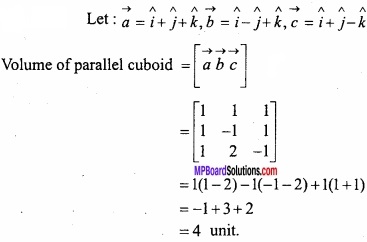
Question 10.
If \(\vec { a } \) = 2\(\hat { i } \) – 3\(\hat { j } \) + \(\hat { k } \), \(\vec { b } \) = \(\hat { i } \) – \(\hat { j } \) + 2\(\hat { k } \) and \(\vec { c } \) = 2\(\hat { i } \) + \(\hat { j } \) – \(\hat { k } \) then find the value of [ \(\vec { a } \) \(\vec { b } \) \(\vec { c } \) ]
Solution:
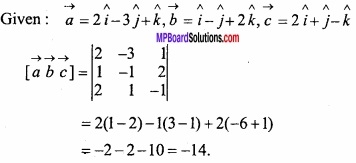
Question 11.
If \(\vec { a } \) = 3\(\hat { i } \) – \(\hat { j } \) + 2\(\hat { k } \), \(\vec { b } \) = 2\(\hat { i } \) + \(\hat { j } \) – \(\hat { k } \) and \(\vec { c } \) = \(\hat { i } \) – 2\(\hat { j } \) + 2\(\hat { k } \) then, find the value of \(\vec { a } \), \(\vec { b } \), \(\vec { c } \)?
Solution:
Solve like Q.No.10.
![]()
Question 12.
If \(\vec { a } \) = \(\hat { i } \) – 2\(\hat { j } \) + 3\(\hat { k } \), \(\vec { b } \) = – \(\hat { i } \) + 3 \(\hat { j } \) – 4 \(\hat { k } \) and \(\vec { c } \) = \(\hat { i } \) – 3\(\hat { j } \) + 5\(\hat { k } \) then prove that \(\vec { a } \), \(\vec { b } \), \(\vec { c } \) are coplanar?
Solution:
If \(\vec { a } \), \(\vec { b } \), \(\vec { c } \) are coplanar then
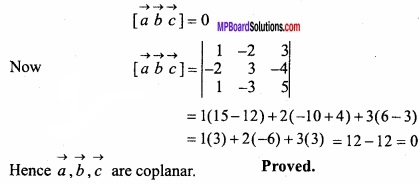
Question 13.
Prove that 2\(\hat { i } \) – \(\hat { j } \) + \(\hat { k } \), \(\hat { i } \) + 2\(\hat { j } \) – 3\(\hat { k } \) and 3\(\hat { i } \) – 4\(\hat { j } \) + 5k are coplanar?
Solution:
Let \(\vec { a } \) = 2\(\hat { i } \) – \(\hat { j } \) + \(\hat { k } \), \(\hat { i } \) + 2\(\hat { j } \) – 3\(\hat { k } \) and 3\(\hat { i } \) – 4\(\hat { j } \) + 5\(\hat { k } \)
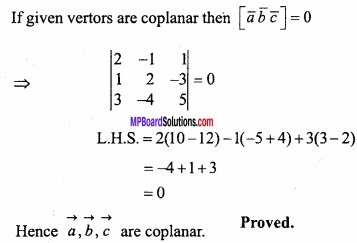
Question 14.
(A) Find the value of λ for which the vectors λ\(\hat { i } \) + 3\(\hat { j } \) + 2\(\hat { k } \), 2\(\hat { i } \) + 2\(\hat { j } \) + 3\(\hat { k } \) and 2\(\hat { i } \) + 3\(\hat { j } \) + 4\(\hat { k } \) are coplanar?
Solution:
Let \(\vec { a } \) = λ\(\hat { i } \) + 3\(\hat { j } \) + 2\(\hat { k } \), \(\vec { b } \) = 2\(\hat { i } \) + 2\(\hat { j } \) + 3\(\hat { k } \) and 2\(\hat { i } \) + 3\(\hat { j } \) + 4\(\hat { k } \) are coplanar?
Solution:
Let \(\vec { a } \) = λ\(\hat { i } \) + 3\(\hat { j } \) + 2\(\hat { k } \), \(\vec { b } \) = 2\(\hat { i } \) + 2\(\hat { j } \) + 3\(\hat { k } \), \(\vec { c } \) = 2\(\hat { i } \) + 3\(\hat { j } \) + 4\(\hat { k } \)
Given vector are coplanar if
[ \(\vec { a } \) \(\vec { b } \) \(\vec { c } \) ] = 0
\(\left|\begin{array}{lll}
{\lambda} & {3} & {2} \\
{2} & {2} & {3} \\
{2} & {3} & {4}
\end{array}\right|\) = 0
⇒ λ(8 – 9) -2(12 – 6+ 2 (9 – 4) = 0
⇒ -λ – 12 + 10 = 0
⇒ λ = -2.
(B) Find the value of λ for which given vectors are coplanar
\(\hat { i } \) – \(\hat { j } \) + \(\hat { k } \), 2\(\hat { i } \) + \(\hat { j } \) – \(\hat { k } \), λ\(\hat { i } \) – \(\hat { j } \) + λ\(\hat { k } \)
Solution:
Solve like Q.No. 14 (A)
Answer:
λ = 1
(C) Find the value of λ for which the given vectors are coplanar 2\(\hat { i } \) – \(\hat { j } \) + \(\hat { k } \), \(\hat { i } \) + 2\(\hat { j } \) – 3\(\hat { k } \) and 3\(\hat { i } \) + λ\(\hat { j } \) + 5\(\hat { k } \)?
Solution:
Solve like Q.No. 14 (A)
Answer:
λ = – \(\frac{18}{5}\)
![]()
Question 15.
If the angle between two unit vectors \(\vec { a } \) and \(\vec { b } \) is θ then prove that:
cos \(\frac { \theta }{ 2 } \) = \(\frac{1}{2}\) |\(\bar { a } \) + \(\bar { b } \)| is θ then prove that:
sin \(\frac { \theta }{ 2 } \) = \(\frac{1}{2}\) |\(\bar { a } \) – \(\bar { b } \)|
Solution:
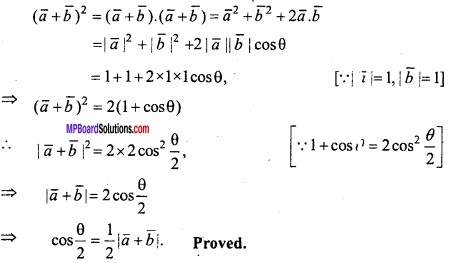
Question 16.
The angle between two vectors \(\vec { a } \) and \(\vec { b } \) is θ then prove that:
sin \(\frac { \theta }{ 2 } \) = \(\frac{1}{2}\) |\(\bar { a } \) – \(\bar { b } \)|
Solution:
sin \(\frac { \theta }{ 2 } \) = \(\frac{1}{2}\) |\(\bar { a } \) – \(\bar { b } \)|
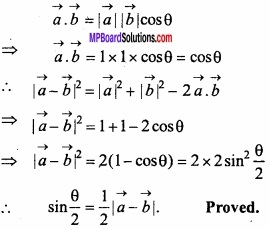
Question 17.
In any traiangle prove that ABC?
(A) ac cos B – bc cos A = a2 – b2?
(B) 2(bc cos A + ca cos B + ab cos C) = a2 + b2 + c2?
Solution:
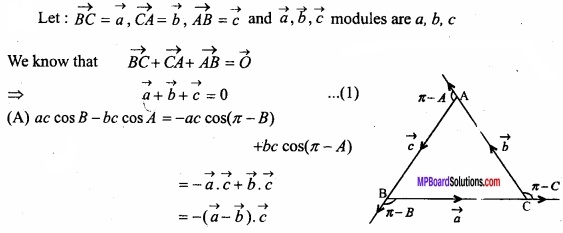
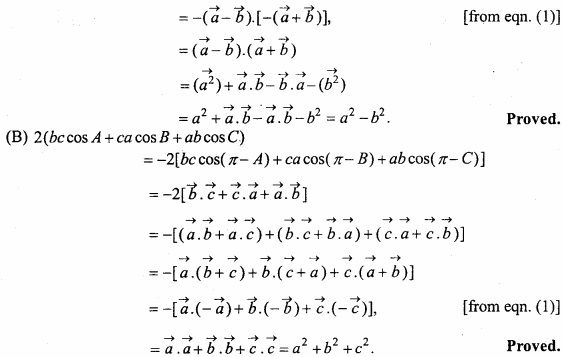
Question 18.
In ∆ABC prove by vector method c = acosB + bcosA?
Solution:
In ∆ABC
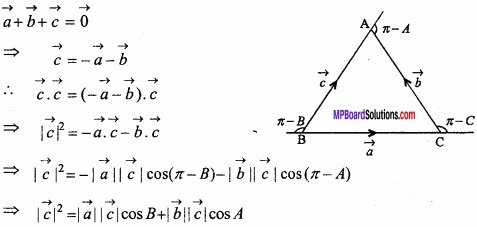
⇒ c2 = ac cos B + bc cos A
⇒ c2 = c(a cos B + b cos A)
⇒ c = a cos B + b cos A. Proved.
Question 19.
In ∆ABC prove by vector method
b2 = a2 + c2 – 2ac cos B?
Solution:
In ∆ABC we know that
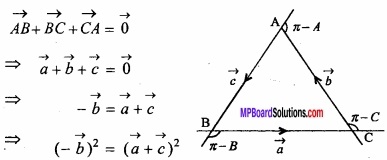

Question 20.
In ∆ABC Prove the following:
(A) a2 = b2 + c2 – 2bc cos A?
(B) c2 = a2 + b2 – 2ab cos C?
Solution:
Solve like Q.No. 19
Question 21.
(A) Find the unit vector normal to the vector \(\vec { a } \) = 2\(\hat { i } \) + 2\(\hat { j } \) + \(\hat { k } \) and \(\vec { b } \)
= 4\(\hat { i } \) + 4\(\hat { j } \) – 7\(\hat { k } \)?
Solution:
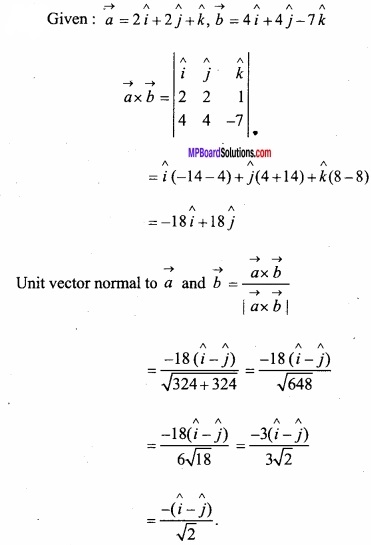
(B) Find the unit vector normal to the vectors \(\vec { a } \) = \(\hat { i } \) – \(\hat { j } \) + \(\hat { k } \) and \(\vec { b } \) =
\(\hat { i } \) + 2\(\hat { j } \) – \(\hat { k } \)?
Solution:
Solve like Q.No. 21 (A)
![]()
(C) Find the unit vector normal to the vectors \(\vec { a } \) = 3\(\hat { i } \) + \(\hat { j } \) – 2\(\hat { k } \) and \(\vec { b } \) = 2\(\hat { i } \) + 3\(\hat { j } \) – \(\hat { k } \)?
Solution:
Solve like Q.No. (A)
Answer:

Question 22.
Find the unit vector normal to the vectors \(\vec { a } \) = 2\(\hat { i } \) – \(\hat { j } \) + \(\hat { k } \) and \(\vec { b } \) = 3\(\hat { i } \) – 4\(\hat { j } \) – \(\hat { k } \)?
Solution:
Solve like Q.No. 21 (A)
Answer:

Question 23.
Find the area of parallelogram whose digonals are 3\(\hat { i } \) + \(\hat { j } \) – 2\(\hat { k } \) and \(\hat { i } \) – 3\(\hat { j } \) + 4\(\hat { k } \)?
Solution:
ABCD is parallelogram whose diagonals are \(\vec { A } \)C = \(\vec { d } \)1 and \(\vec { B } \)D = \(\vec { d } \)2
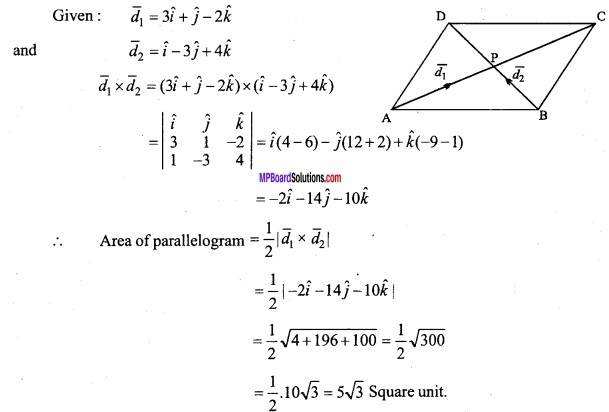
Question 24.
By vector method prove that the square of the hypotenuse of a right angle triangle is equal to the sum of the square of the other two sides?
Solution:
Let OAB be a right angled triangle at O. Taking O as the origin. Let the position vector of \(\vec { a } \) and \(\vec { b } \) be a and b respectively then \(\vec { O } \)A = \(\vec { a } \) and \(\vec { O } \)B = \(\vec { b } \) and ∠BOA = 90°.
∴\(\vec { a } \). \(\vec { b } \) = 0
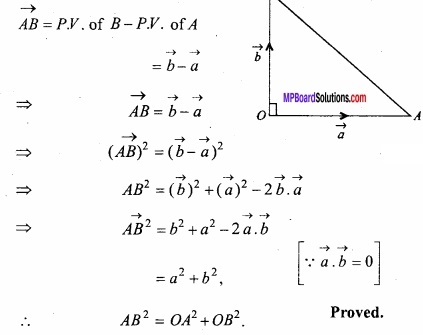
Question 25.
Find the moment of force 5\(\hat { i } \) + \(\hat { k } \) passing through the point 9\(\hat { i } \) – \(\hat { j } \) + 2\(\hat { k } \) about the point 3\(\hat { i } \) + 2\(\hat { j } \) + \(\hat { k } \)?
Solution:
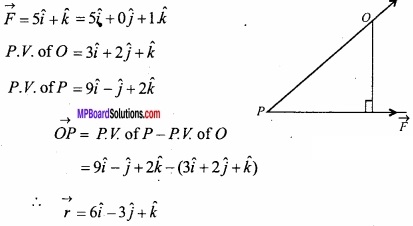
Moment of the force \(\vec { F } \) about the point O = \(\vec { r } \) × \(\vec { F } \)
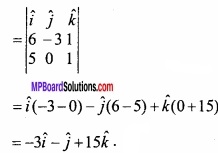
Question 26.
(A) Prove that:

Solution:
![]()
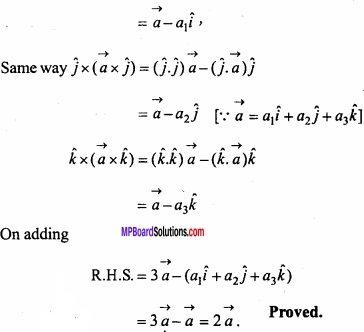
(B) Prove that:
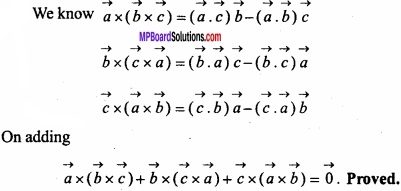
Question 27.
Prove that:
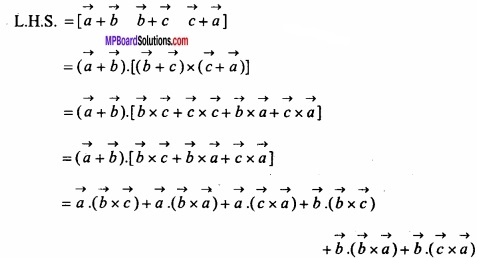

Question 28.
Two forces are represented by vectors \(\vec { p } \) = 4\(\hat { i } \) + \(\hat { j } \) – 3\(\hat { k } \) and \(\vec { Q } \) = 3\(\hat { i } \) + \(\hat { j } \) – \(\hat { k } \) displace a particle from points (1,2,3) to point2? (5,4,1)? Find the work done by the forces?
Solution:
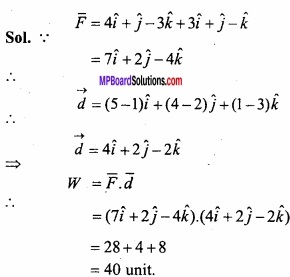
Question 29.
Two forces 4\(\hat { i } \) + 3\(\hat { j } \) and 3\(\hat { i } \) + 2\(\hat { j } \) are acting on a particle, Due to the forces the particle is displaced from the point \(\hat { i } \) + 2\(\hat { j } \) to the point 5\(\hat { i } \) + 4\(\hat { j } \)? Find the work done by the forces?
Solution:
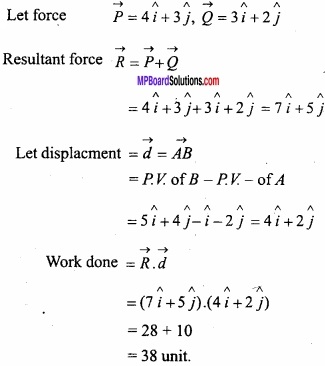
![]()
Question 30.
Alorce of 6 units along the direction of vector 2\(\hat { i } \) – 2\(\hat { j } \) + \(\hat { k } \) acts on a partical? The partical is displaced from point \(\hat { i } \) + 2\(\hat { j } \) + 3\(\hat { k } \) to 5\(\hat { i } \) + 3\(\hat { j } \) + 7\(\hat { k } \). Find the work done by the force?
Solution:
Unit vector parllel to vector 2\(\hat { i } \) – 2\(\hat { j } \) + \(\hat { k } \)
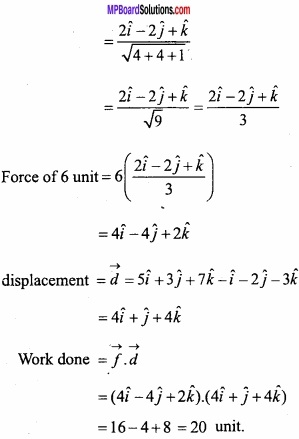
Question 31.
Prove that |\(\vec { a } \) – \(\vec { b } \) \(\vec { b } \) – \(\vec { c } \) \(\vec { c } \) – \(\vec { a } \)| = 0?
Solution:
We know
